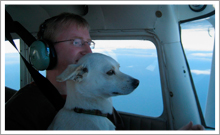| ||||
| | FT News | INSIDE AOPA | TRAINING PRODUCTS | FINAL EXAM | |||
TRAINING TIPsForecasting change
What if one kind of weather is giving way to another? Forecast fine print helps pin down the time and extent of change. That’s when forecasters employ shorthand terms like TEMPO, PROB, and BECMG in terminal aerodrome forecasts (TAFs). There’s no guarantee, of course, that the weather will oblige. Your job is to study the information and decide. How to weigh your decision was the subject of vigorous discussion in this thread in the AOPA Aviation Forum.
Portions of a TAF for Pittsburgh International Airport (KPIT) that is presented in Chapter 7 of the Aeronautical Information Manual (7-1-30) show the shorthand in action: “FM 1930 30015G25KT 3SM SHRA OVC015; TEMPO 0920/0922 1/2SM +TSRA OVC008CB.”
The AIM explains: Temporary (TEMPO) changes are expected for less than one hour and in total, less than half of the period between the two-digit hour beginning and two-digit hour ending the time period, in this case from 2000Z to 2200Z.
Later in the forecast appears this information: “PROB30 1004/1007 1SM RA BR; FM101015 18005KT 6SM SHRA OVC020; BECMG 1013/1015 P6SM NSW SKC.” There’s a 30 percent probability of the forecasted conditions between 0400Z and 0700Z. From 1015Z visibility is improving, and conditions are becoming (BECMG) clear with greater than six statute miles visibility and no significant weather (NSW) between 1300Z and 1500Z.
To evaluate any forecast, it helps to understand how meteorologists construct the big picture using instruments sent aloft on weather balloons. “Pressure measurements enable meteorologists to map areas of high and low pressure at altitude, which determine wind strength and direction. The temperature and humidity data enable them to calculate the atmosphere’s stability, which is used to predict the weather over the next several hours,” explained meteorologist Jack Williams in “The Weather Never Sleeps” in the March 2010 AOPA Flight Training.
In flight, keep tabs on weather changes as prescribed in the Aug. 22, 2003, Training Tip.
And here’s another tip about NSW: You’ll only see the term in information blocks with BECMG or TEMPO. YOUR PARTNER IN TRAININGHave you applied for your FAA medical certificate? You’ll need to do so prior to your first solo flight if you’re going for your private pilot certificate. Getting the medical certificate can take some time if you hit a snag with the FAA. Take all the guesswork out of it by engaging AOPA’s medical resources. Among the services AOPA offers is a database to locate an FAA aviation medical examiner to perform the exam; specialized information reports on common medical conditions that crop up; and TurboMedical, an online interactive tool that guides you through the FAA medical application form. As an AOPA member, you can log on today or call a medical certification specialist for more personalized help at 800/USA-AOPA.
Student pilots who join AOPA are three times more likely to complete their flight training. Membership includes unlimited access to aviation information by phone (800/USA-AOPA, weekdays from 8:30 a.m. to 6 p.m. Eastern time) or from AOPA Flight Training Online or AOPA Online. If you’re not already a member, join today and get the pilot’s edge. Login information is available online. FLIGHT TRAINING NEWSHigh school students get taste of flightStudents at Boynton Beach High School in southern Florida will now have the opportunity to give flying a try, thanks to two airplanes recently donated to the Aerospace Science Academy program at the school. The airplanes are a Cessna 310 that will be used for maintenance and then displayed, and a light sport SportStar Max that will be used for flight training. The program is a partnership between the school and Embry-Riddle Aeronautical University. Students in the maintenance track will have the ability to graduate as an apprentice technician, and flight students will be able to fly for between $35 and $40 an hour. New simulator research seeks to improve flight instructionA new simulator setup at Arizona State University is attempting to better train flight instructors in more realistic scenarios. A combination of two low-cost PC-based devices, the simulator gives instructors a cost-effective way to practice flying from the right seat, as well as reacting to a student in real-life scenarios. The device is part of the Air Force Research Laboratory adjacent to ASU’s campus, and is part of a study aimed at better preparing civilian and military instructors. UND Army ROTC, helicopter programs honoredThe Army ROTC program at the University of North Dakota was recently named best in the brigade, a 10-state region in the Midwest. The program has 150 cadets and is the only installation in the country that offers its cadets the opportunity to obtain helicopter training while still on campus. That helicopter training consists of experience in Sikorsky S-300C light helicopters, for which Sikorsky recognized the school at this year’s Heli-Expo. First CFI renewal via Webinar approvedThe FAA has approved AVSeminars to give the first flight instructor renewals via live Webinar. The Webinar is like a live flight instructor refresher course, but it’s done in front of any computer. AVSeminar’s first renewal course is scheduled for April 3 and 4 for $69. The course will work on a PC or a Mac, with Internet access, a webcam, and a microphone required. Visit the company’s Web site for more information. School briefs
inside aopaBecome an aerodynamics expertYour instructor has probably taught you about stalls, spins, and other potentially bad things that happen when you don’t respect the laws of aerodynamics. But did you really understand it all? Get a thorough briefing on aerodynamics in the AOPA Air Safety Foundation course Essential Aerodynamics: Stalls, spins, and safety . Here’s what one course taker had to say about his experience: “I am very impressed with the course. The graphics, videos, and explanations are first rate, kept my attention and should be something every pilot gets an opportunity to see whether they think they know it all or not.” The foundation’s aerodynamics course is one of many interactive online courses, so try them all. Bank of America comes through for AOPA memberWhen Adam Epstein, an insurance adjuster from Milford, Mass., decided to buy an airplane, he definitely shopped around—but not for financing. “I went straight to AOPA,” he says, “because I value their opinion and they provide great resources.” When he learned that the financing would be through Bank of America, that was a plus: Bank of America is Epstein’s regular bank. Read more >> You and AOPA benefit from rental car discountsYou’re right to ask, “What’s in it for me?” when it comes to the discounts you receive at Alamo, Avis, Enterprise, and Hertz as an AOPA member. But AOPA benefits along with you. Part of your rental fee is returned to AOPA by the rental companies so that the association can put those funds to use on behalf of general aviation. Read more >> TRAINING PRODUCTSWindsock iPhone appAs a student pilot, you’re likely well tuned in to the crosswinds on the day of your training flight. Make determining the crosswind component easy and quick with Windsock, a new iPhone application. Simply select the runway in use, and spin the dial to find the headwind, tailwind, or crosswind component. It works for winds aloft too. Visit the Web site or purchase from the iTunes app store for less than a dollar.
Note: Products listed have not been evaluated by ePilot editors unless otherwise noted. AOPA assumes no responsibility for products or services listed or for claims or actions by manufacturers or vendors. FINAL EXAMQuestion: I’m planning my first cross country flight and I’m wondering what the difference is between a sectional chart and a world aeronautical chart (WAC).
Answer: Both charts are used for VFR navigation. They also provide similar topographical relief information and aeronautical information. The main difference between the two is the scale. For a sectional chart the scale is 1:500,000, which means that every inch depicted on the chart represents about seven nautical miles (500,000 inches). The scale on a world aeronautical chart is even greater, at 1:1,000,000. The smaller scale also means there are some details available on the sectional chart that are not found on the WAC. Since they lack the detail of other charts, WACs are not recommended for exclusive use by pilots of low-speed, low-altitude aircraft. Sectional charts or terminal area charts are much better options. To find out more about the charts available to pilots see Chapter 9 of the Aeronautical Information Manual. Also see the AOPA Flight Training article “ Chart Basics.”
Got a question for our technical services staff? E-mail [email protected] or call the Pilot Information Center, 800/872-2672. Don’t forget the online archive of “Final Exam” questions and answers, searchable by keyword or topic. Picture Perfect
AVIATION EVENTS & WEATHER To include an event or to search all events in the calendar, visit AOPA Online. For airport details, including FBO fuel prices, see AOPA’s Airport Directory Online. Flight Instructor Refresher ClinicsThe next AOPA Air Safety Foundation Flight Instructor Refresher Clinics are scheduled in San Mateo, Calif., and Baltimore, Md., March 13 and 14; Ontario, Calif., March 20 and 21; Phoenix, Ariz., King of Prussia, Pa., and Virginia Beach, Va., March 27 and 28; San Diego, Calif., Cincinnati, Ohio, and Ashburn, Va., April 10 and 11; Denver, Colo., Boston, Mass., and Salt Lake City, Utah, April 17 and 18; Tampa, Fla., Atlanta, Ga., and Indianapolis, Ind., April 24 and 25. For a complete schedule, see AOPA Online.
Can’t make it in person? Sign up for the CFI Refresher Online. AOPA Air Safety Foundation Safety SeminarsAOPA Air Safety Foundation Safety Seminars are scheduled in Rochester, Minn., March 8; Cedar Rapids, Iowa, and Portland, Ore., March 9; Seattle, Wash., and Olathe, Kan., March 10; Bedford, Mass., March 15; Ypsilanti, Mich., March 22; Birmingham, Ala., Northbrook, Ill., and Cleveland, Ohio, March 23; Marietta, Ga., Bolingbrook, Ill., Gaithersburg, Md., and Columbus, Ohio, March 24; Rockford, Ill., and Indianapolis, Ind., March 25; Brooklyn Center, Minn., March 29; Clayton, Mo., and Pittsburgh, Pa., April 5; Springfield, Mo., and New Cumberland, Pa., April 6; Allentown, Pa., April 7; King of Prussia, Pa., April 8; Lynchburg, Va., April 13. Topics vary—for details and a complete schedule, see AOPA Online. | Got news? Contact ePilot. Having difficulty using this service? Visit the ePilot Frequently Asked Questions now at AOPA Online or write to [email protected]. |
| Member Tools : Send feedback | Update member profile | Change email address | Unsubscribe | ePilot Archive Editorial Team: ePilot Flight Training Editor : Ian Twombly | ePilot Editor: Sarah Brown | Contributor: Alton Marsh |

 Some aviation weather forecasts are straightforward. You know at a glance whether to fly. Clear skies with light and variable winds spanning the entire forecast period say “go.” Low clouds, fog, and precipitation from a warm front limping into town say “no.”
Some aviation weather forecasts are straightforward. You know at a glance whether to fly. Clear skies with light and variable winds spanning the entire forecast period say “go.” Low clouds, fog, and precipitation from a warm front limping into town say “no.”


